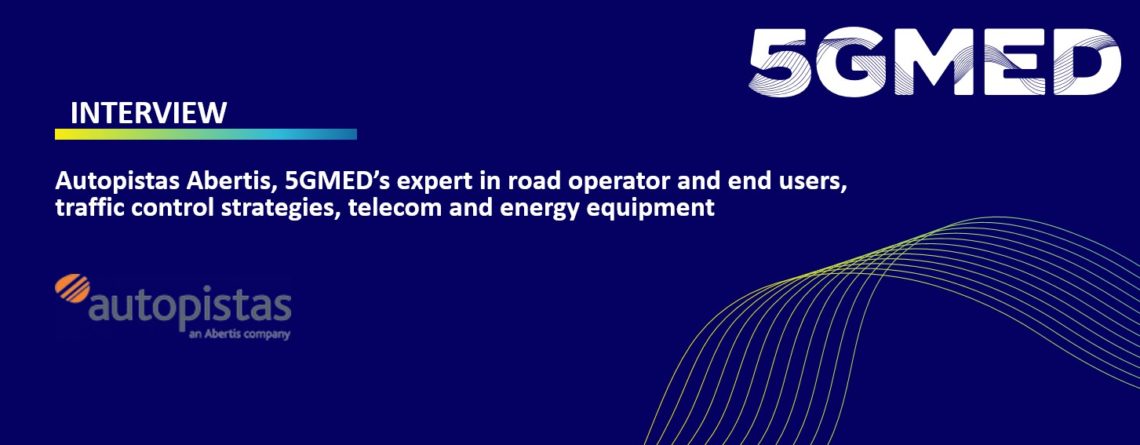Autopistas Abertis, 5GMED’s expert in road operator and end users, traffic control strategies, telecom and energy equipment
Autopistas is part of the Abertis Group, one of the leading international toll road operators, with more than 8.700 kilometres of high-capacity, high-quality roads in 16 countries in Europe, America and Asia. It is the leading national toll road operator in countries such as Spain, Chile and Brazil, and also has a significant presence in France, Italy, Mexico, Puerto Rico, Argentina and the USA.
At Abertis Group, driver safety is their top priority, and they continuously invest in technology and smart engineering to ensure that customers have a safe, comfortable, fast and easy journey when they choose their highways. Committed to research and innovation, Abertis combines advances in high capacity infrastructure with new technologies to drive innovative solutions to meet the mobility challenges of the future. They are working on mobility proposals based on barrier-free tolling, a pioneering system implemented in other countries that improves traffic and reduces accidents and pollution.
In Spain, Autopistas is the operator of high-capacity roads with the largest number of kilometres managed and a benchmark company in the infrastructure sector. They are an experienced company that designs, builds and manages sustainable and safe highways to meet the mobility needs of the present and the future. They are an active agent in the development of mobility, working on the basis of sustainable and efficient solutions in the management and maintenance of communication routes. They are at the forefront of innovation for infrastructure development.
Autopistas strives in each project to provide the maximum, managing all phases of the life cycle of an asset in an efficient way. They are committed to public-private collaboration to preserve and develop safe, innovative infrastructures capable of responding to new ways of getting around. Their lines of work are based on improving the mobility of their customers, optimizing information technology services for mobility, and planning and collaborating in the development of infrastructures adapted to new technologies (autonomous and connected driving…). Abertis understands investment in infrastructure as a strategic instrument for the development of society and the environment in which we operate.
Describe your role in the 5GMED project
The role of Abertis Autopistas is to understand the impact of GDPR and systems of data collected in tests and to define the use-cases and their requirements and KPIs. The company supports ICT infrastructure requirements (road infrastructure equipment) and Multi-technology Telematic Control Unit (TCU) for connected vehicles. It provides expertise in the following areas: understanding the road operator and end-users, developing traffic control strategies, cameras with video analytics software, levels 1 and 2 management developments, traffic strategies, telecom and energy equipment, integration and project management.
The specification of cross-border testing in Motorways UC, development, integration and configuration, support for collecting and evaluating data is also a part of the action point of Abertis. Finally, the Spanish road manager is also involved in the impact maximisation of the project.
Define the importance of 5G technologies
The new cooperative connected, and automated mobility (CCAM) requires a communications network that not only allows vehicles to report their position in real-time, but also allows the road operator to transmit traffic strategies that make the traffic safe and smooth. 5G is a wireless technology that helps to achieve these objectives faster than other technologies.
5G technology can help accelerate this new mobility in the following areas:
- Global 5G architecture is perfectly adapted to accommodate roadways and railways or any other mobility services.
- Synergic in both road and rail ecosystems, for shared infrastructure.
- A key concept: this MEC (Multi-access Edge Computing) brings technology resources closer to the end-user. Data is processed and stored at the network’s edge, not at some distant data center, significantly reducing latency.
- Multi-stakeholders combining multiple technologies, synergies.
- Hybrid multi-stakeholder business models aimed at reducing/optimizing the required investment of resources.
- 5G technology allows us to use self-sustainable nodes with green energies, because the computation is in the MEC, not in the sensor, thereby reducing energy requirements
- Finally, 5G is needed for a collaborative, connected and automated mobility.
Explain the impact of the project in short term and long term
The Mediterranean corridor will be the largest corridor in Europe with 5G technology, 65 km between Perpignan (France) and Figueres (Spain); 20 km on the French side and 45km on the Spanish side. The 5GMED project will be a key project for Europe, and for both countries, to share the potential of the 5G network to develop technologies around automated mobility on road and rail.
The 5GMED consortium is working on developing new technologies that show us that 5G technology offers us many advantages and opportunities in terms of technologies and costs.
As a road operator, in the short term, it will be important to demonstrate the potential of the 5G network at all three levels of management and how this technology can accelerate CCAM to achieve Europe’s goals. Technologies such as:
- Level 0 (ROAD): Digitalization (sensors, CV…) with new smart sensors.
- Level 1 (MEC): Edge mobility Hub and Specific Components such as: Local TMC, Video Analytics, Data Gateway, Data Repository….
- Level 2 (CLOUD): Mobility Hub Platform, Global TMC, Data Gateway…..
In the long term, 5GMED will help us to understand the benefits of extending 5G technologies in terms of business. Public-private partnerships can be a good solution to deploy 5G networks that are not yet cost-effective in the short term. Later, we will see that the 5G infrastructure will have to increase in density, for:
- New markets (e.g., mobility, personal services and infotainment, IoT, health etc.).
- New advanced services in the future (liaison between usage and business models).
Regarding the use case 2 Road Infrastructure Digitalization, what are the possible limitations on the execution of intelligent traffic management? Are there any saturation points regarding the number of vehicles?
The main limitation is the lack of sensors around the corridor, the cost of covering the entire 65km corridor is not possible with the budget available in the project. Additionally, the fact of not having many connected vehicles in the tests means that we cannot generate individual traffic strategies, only global strategies for groups of vehicles.
What is the minimum number of sensors needed to achieve a road infrastructure close to its optimal functionality?
In order to have a microscopic vision of the traffic, a sensor is needed every 500 metres. However this may be unrealistic, and therefore the solution is to combine data from connected vehicles with sensors, during this long transition period where a different proportion of vehicles coexist (conventional, connected and automated).
Abertis Autopistas is working with different data sources such as sensors, connected vehicles and available data provided by third parties, in order to understand the potential of combining many resources and minimizing investment costs.
What would be the different traffic strategies implemented in this Use Case?
We are developing traffic strategies at two levels of management:
Level 1: Infrastructure at the MEC layer: At this level, 5G technology offers us new management tools, the objective is to be able to perform a very close management. In this layer we are developing:
- Video analytics technologies that can manage up to 8 cameras per computer.
- Edge mobility HUB collects data from cameras and connected vehicles in the area.
- Local TMC data management with the objective of generating traffic strategies that require very low latency and focus on safety. For instance, if we detect an accident we can send traffic strategies with the objective of speed reduction, change of lane and so on. ….
Level 2: Infrastructure in the Cloud Finally, the last layer is located in the cloud, and we have the mobility HUB where we collect all the data from the different MEC’s and additionally, we can add external data, such as weather conditions, floating data and so on.
The goal is to have as much of a detailed and microscopic vision of the road as possible to generate traffic strategies, with the use of artificial intelligence algorithms. The objective is to send strategies from the control centre to the user, to do with speed and lane changes.
More interviews are available here.
Do not miss our next interview, follow us on our social media for more: Linkedin – Twitter.


